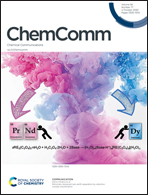Boosting electrocatalytic reduction of nitrogen to ammonia under ambient conditions by alloy engineering†
Abstract
Electrochemical reduction of nitrogen to ammonia under ambient conditions is regarded as a potential approach to tackle the energy-intensive Haber–Bosch process. However, it usually suffers from extremely low ammonia yield and faradaic efficiency due to the lack of highly active and selective electrocatalysts. Herein, fusiform-like ruthenium–copper alloy nanosheets (RuCu-FNs) were prepared by alloy engineering and utilized for the electrocatalytic NRR under ambient conditions. A high FE of 7.2% and an NH3 yield rate of 53.6 μg h−1 mgcat−1 were achieved at −0.1 V vs. RHE, which were better than those of the corresponding non-metallic catalyst and most alloy catalysts. The superior performance was ascribed to the differentiated second catalytic site for achieving both effectively adsorptive activation of chemically inert N2 and intermediate desorption from the catalyst surface. The source of NH3 was also identified with isotopic labeling via a self-developed simple and economic pathway. We provided a feasible pathway for the rational design of electrocatalysts for artificial N2 fixation.



 Please wait while we load your content...
Please wait while we load your content...